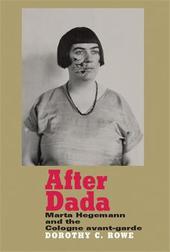
|
After Dada: Marta Hegemann and the Cologne Avant-Garde
Hardback
Main Details
| Title |
After Dada: Marta Hegemann and the Cologne Avant-Garde
|
| Authors and Contributors |
By (author) Dorothy Price
|
| Physical Properties |
| Format:Hardback | | Pages:288 | | Dimensions(mm): Height 240,Width 170 |
|
| Category/Genre | Art and design styles - from c 1900 to now |
|---|
| ISBN/Barcode |
9780719090073
|
| Classifications | Dewey:709.0406 |
|---|
| Audience | | Professional & Vocational | |
|---|
| Illustrations |
Illustrations, colour|Illustrations, black & white
|
|
Publishing Details |
| Publisher |
Manchester University Press
|
| Imprint |
Manchester University Press
|
| Publication Date |
30 November 2013 |
| Publication Country |
United Kingdom
|
Description
What happened in 1920s Cologne 'after Dada'? Whilst most standard accounts of Cologne Dada simply stop with Max Ernst's departure from the city for a new life as a surrealist in Paris, this book reveals the untold stories of the Cologne avant-garde that prospered after Dada but whose legacies have been largely forgotten or neglected. It focuses on the little-known Magical Realist painter Marta Hegemann (1894-1970). By re-inserting her into the histories of avant-garde modernism, a fuller picture of the gendered networks of artistic and cultural exchange within Weimar Germany can be revealed. This book embeds her activities as an artist within a gendered network of artistic exchange and influence in which Ernst continues to play a vital role amongst many others including his first wife, art critic Lou Straus-Ernst; photographers August Sander and Hannes Flach; artists Angelika Fick, Heinrich Hoerle, Willy Fick and the Cologne Progressives and visitors such as Kurt Schwitters and Katherine Dreier. The book offers a significant addition to research on Weimar visual culture and will be invaluable to students and specialists in the field. -- .
Author Biography
Dorothy Rowe is Senior Lecturer in the History of Art at the University of Bristol -- .
ReviewsDorothy Rowe's 'After Dada' redefines our understanding not only of avant-garde activities in Cologne between the wars, but also of the crucial role played by women artists previously given little coverage. Rowe brings to light the careers and works of the, until now, relatively little known Marta Hegemann and Angelika Fick-Hoerle, contextualised within the artistic networks in which they practiced, which included Max Ernst, Anton Raderscheit, August Sandler and Kurt Schwitters. By exploring the major roles played by Hegemann and Fick-Hoerle within this period, Rowe presents a new interpretation of cultural activity during the troubled period between the end of the First World War and the rise of National Socialism. Meticulously researched and convincingly argued, this book will mark a fantastic contribution towards studies in Germany art and culture in the early twentieth century. Mike O'Mahony, Reader in History of Art, University of Bristol The book offers a significant addition to research on Weimar visual culture and will be invaluable to students and specialists in the field. "...her wide-ranging analyses of the work of Hegemann and her circle clearly demonstrate that in this instance, orthodox approaches to categorization and classification have led to a host of misconstructions and misrepre-sentations. As such, Dorothy Rowe's After Dada provides both a worthy appraisal of a neglected artist and a thoughtful and thought-provoking examination of structures of cultural exchange within the Weimar Republic's avant-garde." (THE KURT SCHWITTERS SOCIETY NEWSLETTER: May 2014) -- .
|